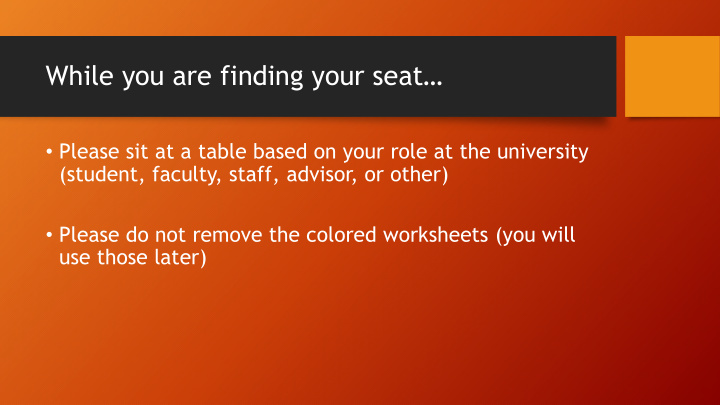



While you are finding your seat… • Please sit at a table based on your role at the university (student, faculty, staff, advisor, or other) • Please do not remove the colored worksheets (you will use those later)
Campus Conversation on Advising Jenny Zorn, Provost and Vice President for Academic Affairs
Provost’s Introduction • Welcome to those watching the Live Stream in the Antelope Valley and on the Main Campus • Please use the Twitter link sent in an earlier email to ask questions • Student Success-Graduation Initiative 2025 • Advising discussions 2017-18 • Visioning
Meeting Goals • Reach consensus on a few important issues related to advising • Create Campus Advising Philosophy • Suggest Campus Model for Advising • Suggest roles and responsibilities between Faculty Advisors and Staff Advisors • Discuss the way forward • Advising Revival Outline: a shared document outlining changes to the advising function • Engage in Q&A about Advising
Meeting Ground Rules • Honest discussion but Respectful discussion • Everyone should feel welcomed in this meeting • Tables have been mixed by role (students, faculty, staff, other) • Each table selects a Facilitator • Table Facilitator coordinates the conversation of the table and reports out • Table Facilitator also takes notes (pen and paper provided) • Speakers list to be maintained • Raise your hand when you wish to contribute to the discussion
Please select a Table Facilitator (5 minutes)
Creating a Campus Advising Philosophy Mission, Vision, and Philosophy of Academic Advising • Our campus needs a written advising philosophy easily accessible to all constituents • Our campus needs a mission/vision statement to serve as a guide to the future of advising • What does CSUB believe about the role and importance of academic advising?
Tablework: Campus Advising Philosophy • Use the Yellow Packet • At your tables, review the Advising Mission Statements from similar institutions on the “Creating Advising Mission Statements” worksheet • Use the worksheet to identify the elements of a mission statement for CSUB • Table Facilitator: will report out the themes from the table. • You have 20 minutes for this activity.
Selected Report Out (15 minutes) Discuss at your tables Table Facilitator will gather themes from across the table Table Facilitator will report on the themes to the room
Suggesting an Organizing Model for Advising Questions to consider when selecting an Advising Model • How does CSUB’s enrollment and size affect its Advising Model? • How does CSUB’s academic advising relate to its mission? • What is the composition of the student body and what are their special needs as they relate to advising?
Organizing Models for Advising • Self-Contained Model : Advising occurs in an advising center with staff advisors. Faculty may be assigned to advise students at the center. Staff Advisors see students through the student’s matriculation. • Faculty-Only Model : All students are assigned to a department advisor, usually a Professor from the student's academic discipline. • Split Model : Advising is carried out by Faculty in their departments, as well as the Staff Advisors in an advising center. Staff Advisors are responsible for a particular subset of students (undeclared, freshmen, probation) or when students have satisfied certain criteria they are reassigned to advisors in the school or department that offers their major. • Other models exist….
Tablework: Organizing Models for Advising • Use the BLUE PACKET • At your tables, answer the guide questions on the “Suggesting an Organizing Model Worksheet” • Complete the guide questions on the worksheet • After the guide questions, make a recommendation as to the Organizing Model for Advising • Table Facilitator: Use the tally sheet to record the results and report out to the group
Report Out and Tally (15 minutes) Discuss at your tables Table Facilitator will tally the results for each type of model Helpers will gather tally sheets from each table The tallied results from each table will be reported to the room
Suggesting Roles and Responsibilities between Faculty Advisors and Staff Advisors • Both Faculty and Staff Advisers have the potential to make positive contributions to the lives of students, by working together — Faculty and Staff advisers can truly support and enhance the impact that both have on students. • Without clear roles and responsibilities, students can be left with confusion regarding whom to consult.
Tablework: Suggesting Roles and Responsibilities • USE the GREEN PACKET • At your tables, use the “Roles and Responsibilities” worksheet to identify how Faculty and Staff/Other Advisors are currently serving students • Use the letters to record your responses on the worksheet • Table Facilitator: Lead a discussion at your table regarding the overlap in responsibilities between the types of Advisors
Discuss results at tables (15 minutes) Table Facilitators will lead discussion of results at each table Helpers will collect worksheets at the end of the conversation
The Way Forward… • CSUB Advising Revival Outline • Authored by the Provost • A vehicle to communicate potential changes to the advising function and generate feedback • Will include general expectations for units and divisions related to advising • Suggest policy revisions and/or additions to serve students better • Will be circulated to all leadership bodies (ASI, Academic Senate, Provost’s Council, DCLC etc.)
Questions and Answers about Advising
Thank you for participating
Recommend
More recommend